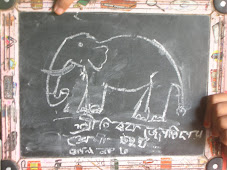When I arrived in Hyderabad, the team, along with Kishor Sir from Mumbai and the PCVC (Pratham Council for Vulnerable Children) were designing a survey to estimate the number of children in ‘visible’ employment – shops and restaurants – in commercial areas of Hyderabad. The pilot would be relatively simple. We decided to head towards Charminar, the symbolic fortress in the middle of Hyderabad’s old city, and our task was to record the name of every fifth shop, and whether or not we could spot any children at work inside.

The adventure began in Parveen Ma’am’s home. Fragrant and light, her home made Byriani was cooked to perfection. We sat like a pack of lions around the pots of food and indulged.

Four servings of Byriani later, the team was raring to go. And we needed the sustenance. Charminar was brimming, bustling, bursting with traders, customers, onlookers, tourists, passers by, pedestrians, vendors, scooters, autos, cars, buses, cycles, cows, dogs, cats, dust, smells, food, litter – humanity in all its variety was out in force and in a hurry when we arrived to survey at Charminar (needless to say, I was looking both incongruous and clumsy trying to juggle an umbrella, clipboard and pen and stay with the group in the middle of all this). The team split at Charminar: one team took the route to Madina through the pearl shops, another went to Purana Pul, and my team took on Ladh Bazaar and the bangle markets (this was very considerately organised so that I could roll sightseeing, bangle shopping, and surveying into one exercise).

The market was dazzling. Thousands of shimmering bangles were rustling and twinkling on the stall racks in every kind of size and colour, every thickness and pattern. Yet I astounded myself by getting so engrossed in the survey work that I forgot to buy bangles. The action on the street was much more interesting. We discovered not so many children working inside the shops, but many of them mingling independently on the street, selling handkerchiefs, safety pins, string, shoelaces. The kids were like firecrackers: bright, uninhibited and feisty.
‘Are you going to school?’ Kishor Sir asked one young boy, Secunder.
‘No, but why should I go to school? I earn 200 rupees per day.’
Our young friend had a point. 200 rupees was indeed a lot of money, especially in the hands of a ten year old.
‘Do you know many children who do the same work as you?’
‘Oh yes, I know all the kids. There are around five hundred in this area and we all get our goods from Firoz Bhai.’
‘Firoz Bhai??’ We leaned in, clipboard at the ready, to hear what else Secunder was going to tell us.
‘Yes! Let me take you to him! You have to meet him.’
The next thing we know, Firoz Bhai is explaining that if we want to educate these children we have to ask them if they want to go, because he only sells goods to them, the children do not work for him. Secunder, meanwhile, is energetically assuring us that school is a good idea, and he will not only find a room for us to hold classes but that he will also round up all the children working in the area and get them to attend.
When we later retold this story to everyone over some fresh samosas at Sunita Ma’am’s house, we discovered the others had also had similar encounters. Together we had spotted over 200 children in the Charminar area. I left Hyderabad just as Kishor Sir and his team were rolling up their sleeves to find out more.
______________________________________________________
www.readindia.org
www.pratham.org.uk
www.prathamusa.org
www.pratham.org

No comments:
Post a Comment